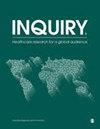Adverse Drug Reactions Resulting From the Use of Chiral Medicines Amoxicillin, Amoxicillin-Clavulanic Acid, and Ceftriaxone: A Mixed Prospective-Retrospective Cohort Study
IF 1.7
4区 医学
Q3 HEALTH CARE SCIENCES & SERVICES
Inquiry-The Journal of Health Care Organization Provision and Financing
Pub Date : 2024-09-17
DOI:10.1177/00469580241273323
引用次数: 0
Abstract
The use of chiral medicines (possessing center(s) of asymmetric carbon) may cause adverse drug reactions (ADRs). The safety assurance of these medicines is critical. We aimed to evaluate registered and commonly used anti-infective chiral medicines circulating in the Tanzanian market to establish their safety profile to protect public health. A mixed prospective-retrospective cohort study was conducted to assess the safety profile of amoxicillin, amoxicillin-clavulanic acid and ceftriaxone injection. ADRs causality assessment was conducted by using World Health Organization (WHO)-Algorithm criteria. Data were collected from 7 tertiary hospitals: Muhimbili National Hospital (MNH), Kilimanjaro Christian Medical Centre (KCMC), Bugando Medical Centre (BMC), Ligula Referral-Regional Hospital (LRRH), Kitete Referral-Regional Hospital (KRRH), Dodoma Referral-Regional Hospital (DRRH), and Mbeya Zonal-Referral Hospital (MZRH). Data were supplemented by those recorded in the WHO-Vigiflow/VigiLyze database within the same monitoring period. Data were analyzed using STATA version-15. The results were considered statistically significant when P < .05. A total of 2522 patients were enrolled in hospitals: MNH (499), KCMC (407), BMC (396), LRRH (387), KRRH (345), DRRH (249), and MZRH (239). Among those, 1197 (47.5%) were treated with ceftriaxone, 585 (23.2%) amoxicillin and 740(29.3%) amoxicillin-clavulanic acid. Out of those, 102 (4.5%) experienced adverse events (AEs), 49 (48%) were due to ceftriaxone, 37 (36.3%) amoxicillin-clavulanic acid and 16 (15.7%) amoxicillin ( P-value .012). A total of 443 participants from the enrolled and WHO-Vigiflow/VigiLyze database were experienced with ADRs. The ADRs affected mainly gastro-intestinal system 234 (53%), skin and subcutaneous tissue 85 (19%), nervous system 49 (11%), respiratory thoracic 22 (5%), and general disorders 18(4%). In this study, approximately 90% of reported AEs were ADRs possible-related to the monitored medicines, with few plausible and certain. Ceftriaxone injection caused more ADRs. Amoxicillin-clavulanic acid was associated with more ADRs than amoxicillin alone. The safety profile of these medicines is still maintained; however, comprehensive monitoring of ADRs is recommended to improve patient safety and enhance overall treatment outcomes.使用手性药物阿莫西林、阿莫西林-克拉维酸和头孢曲松导致的药物不良反应:前瞻性-回顾性混合队列研究
使用手性药物(具有不对称碳中心)可能会导致药物不良反应(ADR)。确保这些药物的安全性至关重要。我们旨在对坦桑尼亚市场上流通的注册和常用抗感染手性药物进行评估,以确定其安全性,从而保护公众健康。我们开展了一项前瞻性和回顾性混合队列研究,以评估阿莫西林、阿莫西林-克拉维酸和头孢曲松注射液的安全性。ADRs 因果关系评估采用世界卫生组织(WHO)算法标准。数据从 7 家三级医院收集:这些医院包括:穆欣比里国立医院(MNH)、乞力马扎罗基督教医疗中心(KCMC)、布甘多医疗中心(BMC)、利古拉地区转诊医院(LRRH)、基特特地区转诊医院(KRRH)、多多马地区转诊医院(DRRH)和姆贝亚地区转诊医院(MZRH)。在同一监测期内,WHO-Vigiflow/VigiLyze 数据库中记录的数据对数据进行了补充。数据使用 STATA 15 版进行分析。当 P < .05 时,结果具有统计学意义。共有 2522 名患者在医院登记:MNH(499 人)、KCMC(407 人)、BMC(396 人)、LRRH(387 人)、KRRH(345 人)、DRRH(249 人)和 MZRH(239 人)。其中,1197 人(47.5%)接受了头孢曲松治疗,585 人(23.2%)接受了阿莫西林治疗,740 人(29.3%)接受了阿莫西林-克拉维酸治疗。其中,102 人(4.5%)出现了不良反应(AEs),49 人(48%)是头孢曲松引起的,37 人(36.3%)是阿莫西林-克拉维酸引起的,16 人(15.7%)是阿莫西林引起的(P 值为 0.012)。共有 443 名参试者在注册和世界卫生组织-Vigiflow/VigiLyze 数据库中出现 ADR。ADR 主要影响胃肠道系统 234 例(53%)、皮肤和皮下组织 85 例(19%)、神经系统 49 例(11%)、呼吸胸腔 22 例(5%)和全身疾病 18 例(4%)。在本研究中,约 90% 报告的不良反应可能与监测药物有关,只有少数似是而非的不良反应。头孢曲松注射液引起的不良反应较多。与单用阿莫西林相比,阿莫西林-克拉维酸引起的不良反应更多。这些药物的安全性仍然保持良好,但建议对不良反应进行全面监测,以改善患者安全,提高整体治疗效果。
本文章由计算机程序翻译,如有差异,请以英文原文为准。
求助全文
约1分钟内获得全文
求助全文
来源期刊
CiteScore
2.50
自引率
0.00%
发文量
192
审稿时长
>12 weeks
期刊介绍:
INQUIRY is a peer-reviewed open access journal whose msision is to to improve health by sharing research spanning health care, including public health, health services, and health policy.

 求助内容:
求助内容: 应助结果提醒方式:
应助结果提醒方式:


